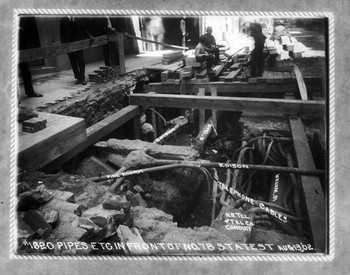F-Line to Dudley
Senior Member
- Joined
- Nov 2, 2010
- Messages
- 9,556
- Reaction score
- 10,449
HRT still opts for 3rd rail way more often than overhead. You're thinking more of LRT being stretched into quasi-HRT overlap, like Los Angeles where some of their sealed-corridor high-floor LRT buildouts are "HRT in everything but name" and are only still called LRT because they happen to recycle the same rolling stock as some of their other non-sealed/mixed-running lines. At extremely high frequencies third rail is many times more durable to Trains Per Hour punishment than overhead wire, and still the overwhelming choice for urban metro systems. You don't have to expend anywhere near as much regular overnight maint-shift labor inspecting for worn third rail as they regularly have to do in Green's Central Subway or Blue's Airport-Wonderland overhead with the wire car track critters after several days worth of service.Thanks for the detailed answers! One more question, why would they want to get rid of the overhead catenary on blue? It seems that the majority of new heavy rail transit systems being built today are opting for overhead catenary vs 3rd rail. Im not sure why, but its definitely a trend, so thats interesting that they would want to go the other direction.
The original reason for doing overhead on Blue's Revere extension was that the 1940's planners had concerns about ice buildup on the third rail during Nor'easters. There were comparably few ocean-hugging/stormy-climate HRT analogues to compare against back then, so they hedged their bets on overhead which had more reference cases for successful ice-busting back in that day. In the last 70 years third-rail heater technology has come a long way, and there have been many more third-rail systems built in extreme weather conditions (NYCT's 1958-opened Rockaway Line being a model proof-of-concept for our winter weather patterns). So third-rail icing is no longer any ops/maint concern. Blue's overhead also takes it on the chin regularly in storms via wind damage in spite of its generally fail-safe rep around icing conditions, so the T isn't getting optimal maint bang-for-buck on the above-ground portion to begin with. If they had to do it over again knowing what they know now, they would've picked third rail all the way. Icing wasn't the risk they thought it would be, but the wind...blows.
The Blue Line Transformation study *does* have a significant "do it over again" component because one of its primary study tasks is fortifying Blue from climate change and sea-level rise. Meaning, relocating all of the electrical feeder plant out of old flood-prone conduits and putting it somewhere it'll stay dry in a major inundation. So every signal and electrical cable on the whole works is going to get relocated somewhere it can stay water-tight in an inundation, and the signal system modernization part of the project will massively consolidate the field hardware to lower its vulnerability. Despite the contact wire being overhead, miles and miles of trunk feeders are all down low and will be replaced. All of that getting replaced any which way lowers the cost threshold for going the extra mile to change the whole thing to third rail in tandem. As long as the feeders are water-tight and the circuit-breakers set up to allow for quicker power restarts after a track-level flood necessitates cutting the power in the first place, third rail can literally be submerged in ocean water for weeks and live to tell about it. Just run a "rust-buster" track critter with faux third-rail shoes over it a few times before powering it back up and it's good as new, as LIRR/MNRR, PATH, and NYCT all found out after Hurricane Sandy (Sandy, of course, bullseyeing feeder conduits as the major concern for fortification). A substantial chunk of the whole system gets replaced any which way, so BLT's thinking is "Why not do the contact system right this time at not much extra premium?" So long as the feeders are water-tight (and indeed, they can probably just keep sawed-off 6 ft. stumps of the old cat poles around for mounting the feeder plant above 50-year flood stage if they want), it works just fine. The extra benefits are that it zeroes-out the wind demerits that currently make the overhead maintenance a P.I.T.A. in storms, simplifies car maint costs somewhat to retire the pantographs, and zeroes-out one type of recurring Blue service disruption where the power switch @ Maverick/Airport doesn't work right on the first try (usually a pantograph that fails to raise/lower correctly).
BLT has many months left to go before it releases its report recs to the FCMB on how to proceed, but given that nearly every above-ground trunk cable--signal and electrical--is going to be wholesale replaced in some form or another for climate-change fortifications changing the contact service isn't a massive extra step. Their findings just need to refine how much of an extra step it is cost-wise before they lean into the general consensus that it's time to do this.


